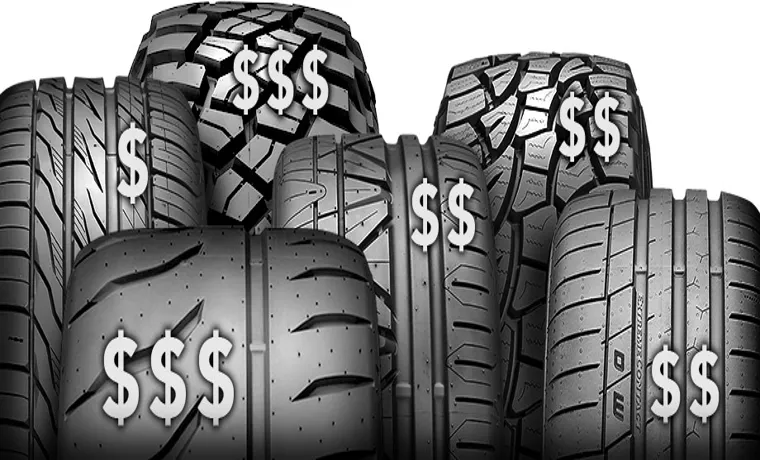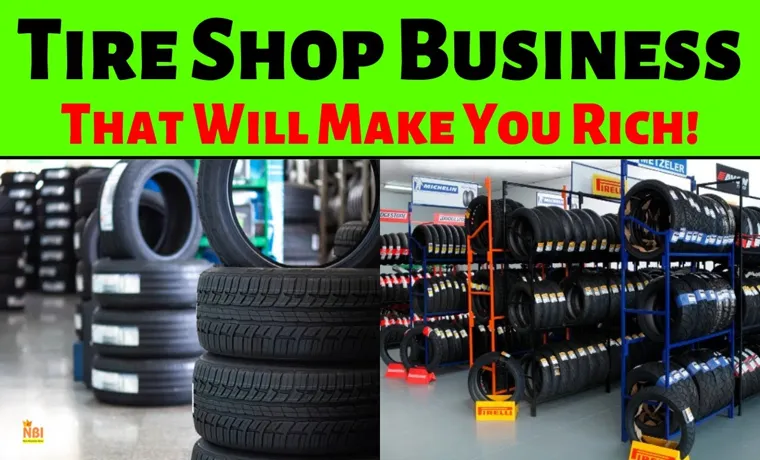Do you have a passion for cars and want to turn it into a profitable business venture? Opening a tire shop might be the perfect fit for you. As with any new business, the cost analysis is a critical step in determining if it is a financially feasible option. In this blog post, we will dive into the various costs associated with opening a tire shop, including equipment, inventory, marketing, and overhead expenses.
We will also discuss some tips for reducing these costs, maximizing profits, and making your dream of owning a profitable tire shop a reality. So, buckle up, grab a cup of coffee, and let’s jump right in!
Table of Contents
Initial Investments
If you’re considering opening a tire shop, one of the most important things to think about is the initial investment required. The amount of money you’ll need to invest will vary depending on a number of factors, such as the location of your shop, the size of the space you’ll be renting, and the equipment and inventory you’ll need to purchase. In general, you should expect to spend at least $50,000 to $100,000 to get your tire shop up and running.
This might seem like a lot of money, but it’s important to remember that this investment will pay off over time, as long as you run your business effectively. Some of the key costs you’ll need to consider include the cost of leasing or buying your space, the cost of equipment like tire changers and balancers, the cost of inventory, and the cost of marketing and advertising your business. By doing your research and planning carefully, you can minimize your expenses and ensure that your tire shop is a success.
Location and Rent Expenses
When starting a new business, location and rent expenses are some of the initial investments that need to be considered. Choosing the right location for your business is crucial as it can determine the success or failure of your venture. The location you choose should be accessible to your target market and have a steady flow of foot traffic.
It should also be in an area where your competition is not too high, or where there is a high demand for your product or service. Rent expenses can vary depending on the location and size of your space. It is important to factor in your budget and projected income when deciding on a rental space.
As a new business owner, finding a balance between a suitable location and affordable rent may require some negotiation and compromise. However, with strategic planning and a bit of research, you can find a location that works for your business while still staying within your budget constraints. Ultimately, investing in a prime location and rent may pay off in the long run if it attracts more customers and generates a higher profit margin.

Legal and License Fees
When starting a new business, it’s important to factor in the legal and license fees that need to be paid upfront. These fees can vary depending on the type of business, but they are necessary to ensure that your company is operating legally and has the necessary permits and licenses to operate. Legal fees can include the cost of setting up the business, drafting contracts, and trademark or copyright registration.
License fees can consist of registering for a business license, permits, and certifications from regulatory bodies. These fees can add up quickly and take a chunk out of your initial investment, but they can also save you from potential legal troubles and ensure that your business is operating within the law. It’s important to research and estimate these costs accurately to avoid any surprises down the road.
Equipment and Inventory Costs
Initial investments are a crucial part of setting up any business, including those in the equipment and inventory industry. Before opening the doors to your company, you will need to invest in the equipment and inventory necessary to get things up and running. Depending on which industry you’re operating in, this initial investment can be quite substantial.
For example, if you’re in the manufacturing industry, you may need to invest in expensive machinery and production lines. If you’re in the retail industry, your investment may be in stocking your shelves with inventory. No matter which industry you’re in, it’s important to carefully consider these initial investments as they will have a huge impact on your long-term success.
By investing in the right equipment and inventory upfront, you’ll be setting yourself up for success in the long run.
Ongoing Operating Expenses
If you’re considering opening a tire shop, it’s important to understand the ongoing operating expenses that come with it. The cost of rent or a mortgage for a commercial space can vary greatly depending on your location, but you should also budget for utilities and insurance. Additionally, you’ll need to purchase inventory including tires, tools, and equipment.
Marketing and advertising expenses should also be taken into account as you’ll want to attract new customers. It’s important to maintain a good reputation in the community as this can lead to repeat business and referrals. Depending on the size of your operation, you may also need to hire additional staff such as mechanics or salespeople.
All of these ongoing expenses can add up quickly, so it’s important to have a solid business plan in place and regularly assess your finances to ensure your business is sustainable. Overall, the cost to open a tire shop can range widely, but it’s safe to budget several thousand dollars per month for ongoing operating expenses.
Employee Salaries and Benefits
When it comes to ongoing operating expenses, one of the most significant costs for many businesses is employee salaries and benefits. Providing competitive salaries and benefits is key to attracting and retaining skilled and motivated staff, which is crucial for the success of any business. However, this can also be a major expense, particularly for small businesses with limited funds.
It’s essential to strike a balance between providing fair compensation and managing costs effectively. A high turnover rate due to dissatisfaction with compensation can be costly in terms of recruitment and training, while offering too much can lead to financial strain. It’s important to regularly review salaries and benefits to ensure they remain competitive and align with the current market trends.
By finding the right balance, businesses can maintain a motivated and loyal workforce while keeping costs under control.
Marketing and Advertising Costs
One of the ongoing operating expenses for businesses is marketing and advertising costs. In today’s competitive market, it’s essential to create a strong brand image and reach potential customers. The cost of advertising and marketing can vary based on the medium chosen, such as traditional print ads, TV commercials, or online ads.
Digital marketing has become a popular and cost-effective way to reach a large audience. Social media marketing can be an effective tool to engage with customers and build a loyal following. However, not all marketing and advertising efforts will have the same impact, and it’s crucial to measure the Return on Investment (ROI) of each campaign.
By analyzing the cost and effectiveness of each strategy, businesses can allocate their marketing budget more efficiently and ensure they are getting the most out of it.
Utilities and Insurance Expenses
When it comes to owning a property, there are ongoing expenses that need to be factored into your budget to ensure that your investment can be sustained in the long run. Two significant expenses include utilities and insurance. Utility expenses refer to the cost of electricity, gas, water, and other essential services.
These fees are often paid monthly and can fluctuate based on usage and the provider you choose. It’s essential to compare utility providers to find the most cost-effective options for your property. Additionally, insurance expenses are a vital aspect of owning a property, as they protect your investment from unforeseen damage or liability.
Insurance can cover anything from natural disasters, fires, theft, or even lawsuits. It’s crucial to adequately insure your property to mitigate any financial risks that could arise from unforeseen events. While utility and insurance expenses may seem like an added cost, they are necessary to manage and maintain your property effectively.
Profit Potential
If you’re looking to start a tire shop, you might be wondering how much it costs. Well, the answer is that it can vary greatly depending on several factors. You’ll need to consider the cost of equipment, inventory, a storefront, and employees.
Additionally, you’ll need to factor in things like insurance and marketing costs. On average, you can expect to spend anywhere from $25,000 to $100,000 or more to start a tire shop. However, the potential for profit can be significant.
With proper management and a solid customer base, you can earn a considerable income from selling tires and providing related services. It’s important to do your research and create a solid business plan before diving into this venture, but with hard work and dedication, owning a tire shop can be a profitable and fulfilling career.
Calculating Profit Margins and Sales Volume
Calculating profit margins is crucial when it comes to determining the success of your business and analyzing its potential for growth. Profit margins refer to the amount of profit you make from each sale, expressed as a percentage of your revenue. To calculate your profit margins, you need to subtract your total costs from your revenue and then divide the result by your revenue.
For example, if your revenue is $10,000 and your total costs are $8,000, your profit would be $2,000. To calculate your profit margin, you would divide $2,000 by $10,000 and then multiply the result by 100 to get a profit margin of 20%. Understanding your profit margin is important when it comes to setting prices and determining your sales volume.
By analyzing your profit margins, you can identify areas where you can reduce costs and increase profits. By setting prices that generate high profit margins, you can increase your revenue and grow your business.
Market Research and Competitive Analysis
When it comes to evaluating profit potential in market research and competitive analysis, there are a few factors to consider. Firstly, you’ll want to examine the market size and demand for the product or service you’re researching. A market with high demand and a large potential customer base offers greater profit potential.
Additionally, it’s important to look at the competition in the market. If there are numerous companies offering similar products or services, you may need to adjust your pricing or marketing strategy to remain competitive and maximize profitability. Another factor to consider is the cost of producing and delivering your product or service.
If costs are high, your profit potential may be lower unless you can find ways to reduce expenses or increase pricing. Finally, keep in mind the potential for future growth and market shifts. A market with growing demand and emerging trends can offer vast profit potential over time.
By taking all of these factors into account, you can accurately evaluate the profit potential of a particular market and make informed business decisions.
Final Thoughts
If you’re thinking about opening a tire shop, you’re likely wondering just how much it’s going to cost you. The answer isn’t a simple one, as there are a lot of different factors that will impact your expenses. Some of the most significant expenses you’ll encounter include the cost of leasing or purchasing a building, the cost of tire inventory, and the cost of equipment and supplies.
It’s critical to do your research and carefully consider all of the expenses associated with opening a tire shop before you begin. Additionally, it’s essential to have a solid business plan and budget in place to ensure that you can secure financing if necessary and stay on track financially as your business grows. Ultimately, the cost of opening a tire shop will vary depending on your location, size, and other specific factors, but with careful planning, it can be a rewarding and profitable investment.
Conclusion
Well, after diving into the nitty-gritty details of what it takes to open a tire shop, it’s clear that the cost can vary quite a bit depending on a number of factors. From location and size to equipment and inventory, there are countless expenses to consider. However, one thing is for sure: it takes far more than a penny to make a tire shop function.
But hey, with some smart financial planning and a commitment to providing excellent service, who knows? You just might be able to turn a pretty good profit and roll out of there with a full set of tires on your own car.”
FAQs
What are the initial costs for opening a tire shop?
The initial costs for opening a tire shop can vary depending on the location, size, and equipment needed. It can range from $50,000 to $200,000.
Is a business plan necessary for opening a tire shop?
Yes, a well-planned business plan is necessary for opening a tire shop. It helps in securing financing, forecasting future growth, and identifying potential risks.
Are there any specific permits or licenses required to open a tire shop?
Yes, there are specific permits and licenses required to open a tire shop. These can include a business license, sales tax permit, environmental permits, and zoning permits.
What types of equipment are necessary for opening a tire shop?
The necessary equipment for a tire shop can vary, but typically includes a tire machine, wheel balancer, air compressor, jacks, and hand tools.
What are some marketing strategies for a new tire shop?
Marketing strategies for a new tire shop can include creating a website and social media pages, offering promotions or discounts, sponsoring local events or sports teams, and creating partnerships with other local businesses.
How much inventory should a new tire shop carry?
The amount of inventory a new tire shop should carry can vary based on the size and location of the shop. Generally, it is recommended to carry a variety of sizes and types of tires to meet the needs of different customers.
What are some common challenges for opening and running a tire shop?
Some common challenges for opening and running a tire shop can include managing inventory and cash flow, competing with larger chain stores, keeping up with industry trends and technology, and managing customer relationships.



